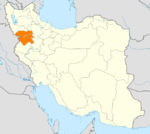- Hawraman
-
Hawrāmān (also Húrāmān) (Kurdish: ههورامان or Hewraman) or Ōrāmān (Persian: اورامان) is a mountainous region located in western Iran or Iranian Kurdistan, which includes the cities of Pawe and Meriwan, and north-eastern Iraq or Iraqi Kurdistan, which includes the city Halabja. The inhabitants of Hewraman are Kurdish people that speak Hewrami, part of the Gorani branch of the Kurdish language group. Hewraman is best known for its unique arrangement of cities and villages built along the mountain slopes of the region. Ancient religions are also practiced throughout Hewraman and the region is home to the ancient holy places of the Yarsan faith.
One of the oldest documents found in the region are Parchments of Awraman that are three documents of Seleucid era and Parthian found in a cave in Kuh-e Salan Mountain, near Shar Hawraman village in 1909. The cave is close to the village of Shahr Hawraman in Kurdistan.A Kurdish villager found a stone jar hermetically sealed and contained decayed millet seeds and several documents. Mirza Saeid Khan (an Ophthalmologist) from Sanandaj (Senna) bought the finds and in October 1913 took them to London where he sent to E. G. Browne.
Some scholars believe that the name Hewraman or Huraman has strong connections to the ancient Zoroastrian faith and claim that the name may have originated from Ahuraman or Ahura Mazda.[1] Ahura Mazda is the name of God in the ancient Indo-Iranian Avestan language and comes from the ancient Zoroastrian faith, which is still widely practiced throughout the region. Many areas in the Hewraman region are believed to be pilgrimage sites for believers of Zoroastranism prior to the advent of Islam.[2]
A poem about Hawraman by famous Kurdish poet Goran"
"A Tour in Hawraman"A mountain mass, wild and defiant, Has gathered blue heaven in its embrace; The mantle of its peak is brilliant white snow, Dark with forest are its silent dales. Waters imprisoned in their tunnels Flow on, nor cease their windings round the hills; The roar and hiss of foam, the shrill song of the brook: Lullabies for grief in the solitude of night. The narrow footpath, feeling its way from tunnel to tunnel, Throws the wayfarer into anxiety without end; On the track rocky stairways, on the side great boulders, That heaven has not yet sent rolling down. Now up hill, now down hill, The bitter and sweet of the wayfarer’s world.
References
- ^ Nyberg, H.S. (1923), The Pahlavi documents of Avroman, Le Monde Oriental, XVII, p.189. This is very interesting for those interested in investigating the survival of Parthian usage of Zoroastrian terminology among the local Kurds of modern day Hawraman (Avroman).
- ^ CHN | Tourism and Travel
External links
- Omid Sālehi, Customs of the Land of Stone and Wind (Ā'in-e Sar'zamin-e Sang va Bād), in Persian, Jadid Online, 5 May 2009, [1].
Audio slideshow: [2] (5 min 39 sec).
Note: The place shown in the above audio slideshow is Orāmān, to the North of Pāveh. As of today (May 2009), this place has a population of approximately 3500.
 Kurdistan Province
Kurdistan ProvinceCapital 
Counties and Cities Divandarreh · ZarrinehSanandaj CountySanandaj · ShuyeshehSaqqez · SahebSarvabadSights Abidar • Zarivar Lake • Hawraman • Pir Shalyar • Old bazaars of Sanandaj • Hajar Khatoon Mosque • Garden of ayatollah Mardokh • Baba Gurgur's mausoleum • Chehelcheshmeh biosphere (Diwandarreh) • Lake of Vahdat dam (Sanandaj) • Tengiwer inscription of Sargon II(Kamyaran) • Garus ancient city • Ahmadzadeh house • House of Kurds (Asef's house) • Khosroabad building • Karaftu • Ziwiyeh • Grand mosque of Sanandaj(Dar-al ehsan) • Avihang mosque • Domenareh mosque (Double Minaret mosuqe),Saqqez • Historic Quran of Negel • Sanandaj museum of natural history • Sanandaj museum • Hajij
Categories:- Mountains of Iran
- Geography of Iraq
- Kurdistan Province
- Iraq geography stubs
- Iran geography stubs
Wikimedia Foundation. 2010.
